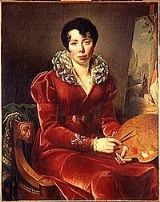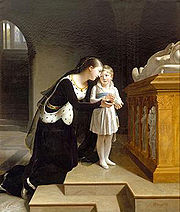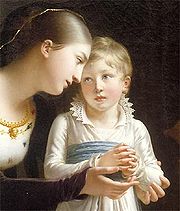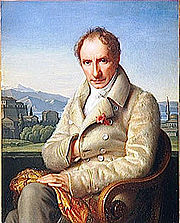
Henriette Lorimier
Encyclopedia
Elisabeth Henriette Marthe Lorimier (7 August 1775, Paris
– 1 April 1854) was a popular portraitist in Paris at the beginning of Romanticism
.
She lived with the French diplomat and philhellene writer Francois Pouqueville
(1770–1838).
 A student of the history painter Jean-Baptiste Regnault
A student of the history painter Jean-Baptiste Regnault
, she soon exhibited fine portraits and genre paintings at the Paris' Salons from 1800 to 1806 and from 1810 to 1814.
In 1805 Princess Caroline Murat
-Bonaparte
, a sister of the Emperor, purchased "La Chèvre Nourricière" a painting exhibited at the 1804 Salon and in 1806 Henriette Lorimier was awarded a First Class Medal for her painting of "Jeanne de Navarre
" which was then purchased by the Empress Josephine de Beauharnais
, consort of the Emperor Napoleon Ier. The painting is still displayed at Josephine's Chateau de la Malmaison
to this day.
 The painting depicts Jeanne of Évreux-Navarre, daughter of Charles II
The painting depicts Jeanne of Évreux-Navarre, daughter of Charles II
(King of Navarre) and widow of Jean V of Montfort Duke of Brittany who died in 1399 and whose third spouse she was. She is here with her second son, Arthur
, future Duke of Brittany. It is considered as exemplifying the mother, inasmuch as the Duchess fulfills her educational duty towards her son and teaches him filial piety.
Exhibited at the 1806 Salon, this painting gained an immense success. Empress Joséphine purchased it outright for her paintings gallery at the Malmaison castel where it remained until her death in 1814. It is now on permanent display in the Empress' music room.

 It is one of the first examples of the painting style known as 'Troubadour
It is one of the first examples of the painting style known as 'Troubadour
' which was brought to fashion by Alexandre Lenoir who created in 1795 the Museum of the French Monuments where were shown in a chronological order the statues and French monuments saved from the destructions of the Revolution. Thousands of visitors went dreaming there in front of the tombs of the great people of the past gathered in just one place, until 1816 when the museum was closed on order of Louis XVIII.
Although it was a historical subject, Jeanne de Navarre did not demonstrate the "noblesse de style" required of a history painting, and thus did not threaten the status quo. "Jeanne de Navarre" was described as a lesson for all mothers because the Duchess is shown fulfilling the duty of instructing her son in filial piety.
For many critics this painting was an example of the success that a woman could obtain within the confines of genre painting
. The author of a Salon review that appeared in Mercure de France
commended Henriette Lorimier for not departing from the graceful subjects in which her sex had the advantage.
 An article published in l'Atheneum, however, confirmed the necessity of her remaining in the domain of genre painting: "We venture to promise her still greater success if she wants to confine herself to painting the sweet emotions of the soul, tender and delicate sentiments, in short, to represent scenes of domestic life, and leave to men historical subjects."
An article published in l'Atheneum, however, confirmed the necessity of her remaining in the domain of genre painting: "We venture to promise her still greater success if she wants to confine herself to painting the sweet emotions of the soul, tender and delicate sentiments, in short, to represent scenes of domestic life, and leave to men historical subjects."
, wife of Prince Murat
, and that, obviously, Henriette Lorimier and her paintings were projected in the limelight of Paris at the time of l'Empire.
This rise in celebrity culminated with the purchase of her second major painting by the Empress herself in 1807!
 At that time, Henriette Lorimier met Francois Pouqueville
At that time, Henriette Lorimier met Francois Pouqueville
who had just returned from his adventures as a prisoner of the Ottoman Empire, and she concentrated on studying and perfecting her painting technique until she felt ready again to exhibit her newer work by 1810.
They lived together until his death in 1838.
The couple was frequently seen in the various "salons" where the intellectual and artistic gentry of Paris was meeting, notably at the Comtesse de Segur's
salon. They befriended many influential figures of the Empire and of the Restoration, such as Chateaubriand, Alexandre Dumas, Ingres, Arago
, and David d'Angers, to name but a few.
Paris
Paris is the capital and largest city in France, situated on the river Seine, in northern France, at the heart of the Île-de-France region...
– 1 April 1854) was a popular portraitist in Paris at the beginning of Romanticism
Romanticism
Romanticism was an artistic, literary and intellectual movement that originated in the second half of the 18th century in Europe, and gained strength in reaction to the Industrial Revolution...
.
She lived with the French diplomat and philhellene writer Francois Pouqueville
Francois Pouqueville
François Charles Hugues Laurent Pouqueville was a French diplomat, writer, explorer, physician and historian, member of the ....
(1770–1838).
Education and Inspiration

Jean-Baptiste Regnault
Jean-Baptiste Regnault was a French painter.Regnault was born in Paris, and began life at sea in a merchant vessel. At the age of fifteen his talent attracted attention, and he was sent to Italy by M. de Monval under the care of Bardin...
, she soon exhibited fine portraits and genre paintings at the Paris' Salons from 1800 to 1806 and from 1810 to 1814.
In 1805 Princess Caroline Murat
Caroline Bonaparte
Maria Annunziata Carolina Murat , better known as Caroline Bonaparte, was the seventh surviving child and third surviving daughter of Carlo Buonaparte and Letizia Ramolino and a younger sister of Napoleon I of France...
-Bonaparte
Bonaparte
The House of Bonaparte is an imperial and royal European dynasty founded by Napoleon I of France in 1804, a French military leader who rose to notability out of the French Revolution and transformed the French Republic into the First French Empire within five years of his coup d'état...
, a sister of the Emperor, purchased "La Chèvre Nourricière" a painting exhibited at the 1804 Salon and in 1806 Henriette Lorimier was awarded a First Class Medal for her painting of "Jeanne de Navarre
Jeanne III of Navarre
Jeanne d'Albret , also known as Jeanne III or Joan III, was the queen regnant of Navarre from 1555 to 1572. She married Antoine de Bourbon, Duke of Vendôme, and was the mother of Henry of Bourbon, who became King of Navarre and of France as Henry IV, the first Bourbon king...
" which was then purchased by the Empress Josephine de Beauharnais
Joséphine de Beauharnais
Joséphine de Beauharnais was the first wife of Napoléon Bonaparte, and thus the first Empress of the French. Her first husband Alexandre de Beauharnais had been guillotined during the Reign of Terror, and she had been imprisoned in the Carmes prison until her release five days after Alexandre's...
, consort of the Emperor Napoleon Ier. The painting is still displayed at Josephine's Chateau de la Malmaison
Château de Malmaison
The Château de Malmaison is a country house in the city of Rueil-Malmaison about 12 km from Paris.It was formerly the residence of Joséphine de Beauharnais, and with the Tuileries, was from 1800 to 1802 the headquarters of the French government.-History:Joséphine de Beauharnais bought the...
to this day.
Jeanne de Navarre

Charles II of Navarre
Charles II , called "Charles the Bad", was King of Navarre 1349-1387 and Count of Évreux 1343-1387....
(King of Navarre) and widow of Jean V of Montfort Duke of Brittany who died in 1399 and whose third spouse she was. She is here with her second son, Arthur
Arthur III, Duke of Brittany
Arthur III , known as the Justicier and as Arthur de Richemont, was Lord of Parthenay and titular Count of Richmond in England and for eleven months at the very end of his life, Duke of Brittany and Count of Montfort after inheriting those titles upon the death of his nephew.-Biography:Belonging...
, future Duke of Brittany. It is considered as exemplifying the mother, inasmuch as the Duchess fulfills her educational duty towards her son and teaches him filial piety.
Exhibited at the 1806 Salon, this painting gained an immense success. Empress Joséphine purchased it outright for her paintings gallery at the Malmaison castel where it remained until her death in 1814. It is now on permanent display in the Empress' music room.


Troubadour
A troubadour was a composer and performer of Old Occitan lyric poetry during the High Middle Ages . Since the word "troubadour" is etymologically masculine, a female troubadour is usually called a trobairitz....
' which was brought to fashion by Alexandre Lenoir who created in 1795 the Museum of the French Monuments where were shown in a chronological order the statues and French monuments saved from the destructions of the Revolution. Thousands of visitors went dreaming there in front of the tombs of the great people of the past gathered in just one place, until 1816 when the museum was closed on order of Louis XVIII.
Although it was a historical subject, Jeanne de Navarre did not demonstrate the "noblesse de style" required of a history painting, and thus did not threaten the status quo. "Jeanne de Navarre" was described as a lesson for all mothers because the Duchess is shown fulfilling the duty of instructing her son in filial piety.
For many critics this painting was an example of the success that a woman could obtain within the confines of genre painting
Genre painting
Genre works, also called genre scenes or genre views, are pictorial representations in any of various media that represent scenes or events from everyday life, such as markets, domestic settings, interiors, parties, inn scenes, and street scenes. Such representations may be realistic, imagined, or...
. The author of a Salon review that appeared in Mercure de France
Mercure de France
The Mercure de France was originally a French gazette and literary magazine first published in the 17th century, but after several incarnations has evolved as a publisher, and is now part of the Éditions Gallimard publishing group....
commended Henriette Lorimier for not departing from the graceful subjects in which her sex had the advantage.

La chèvre nourricière
However, her first painting that was commented upon was La Chèvre Nourricière (The nursing goat) which represents a young mother who is unable to nurse her child, sadly watching a goat performing this service (partly visible in the background of her autoportrait on the top right). Critics claimed that this scene of maternal love and regret could only have been painted by a woman and confirmed the appropriateness of such subjects for women painters. This praise has to be considered in its context in 1804 and with the fact that the painting was purchased in 1805 by Caroline BonaparteCaroline Bonaparte
Maria Annunziata Carolina Murat , better known as Caroline Bonaparte, was the seventh surviving child and third surviving daughter of Carlo Buonaparte and Letizia Ramolino and a younger sister of Napoleon I of France...
, wife of Prince Murat
Joachim Murat
Joachim-Napoléon Murat , Marshal of France and Grand Admiral or Admiral of France, 1st Prince Murat, was Grand Duke of Berg from 1806 to 1808 and then King of Naples from 1808 to 1815...
, and that, obviously, Henriette Lorimier and her paintings were projected in the limelight of Paris at the time of l'Empire.
This rise in celebrity culminated with the purchase of her second major painting by the Empress herself in 1807!
Artistic and intellectual social life

Francois Pouqueville
François Charles Hugues Laurent Pouqueville was a French diplomat, writer, explorer, physician and historian, member of the ....
who had just returned from his adventures as a prisoner of the Ottoman Empire, and she concentrated on studying and perfecting her painting technique until she felt ready again to exhibit her newer work by 1810.
They lived together until his death in 1838.
The couple was frequently seen in the various "salons" where the intellectual and artistic gentry of Paris was meeting, notably at the Comtesse de Segur's
Sophie Rostopchine, Comtesse de Ségur
Sophie, Countess of Ségur was a French writer of Russian birth....
salon. They befriended many influential figures of the Empire and of the Restoration, such as Chateaubriand, Alexandre Dumas, Ingres, Arago
François Arago
François Jean Dominique Arago , known simply as François Arago , was a French mathematician, physicist, astronomer and politician.-Early life and work:...
, and David d'Angers, to name but a few.
Works (partial)
- Autoportrait, 1801,
- Une jeune fille, près d'une fenêtre, pleurant sur un passage d'Atala, 1802,
- La Chèvre nourrice, 1804,
- Autoportrait, 1805,
- Portrait de Sophie Regnault, 1805,
- Jeanne de Navarre, 1806,
- Portrait de Madame Desmaret, 1807,
- L'Enfant reconnaissant, 1810,
- Portrait de feu M. Joseph Delaleu, 1812,
- Portrait de la marquise de Reinepont, 1816,
- Portrait de Nicolas Lupot, Luthier,
- Portrait de Madame de Margolis,
- Portrait de François-Charles-Hugues-Laurent Pouqueville, 1830,
- Portrait de Céleste Buisson de Lavigne, vicomtesse de Chateaubriand, 1840.

